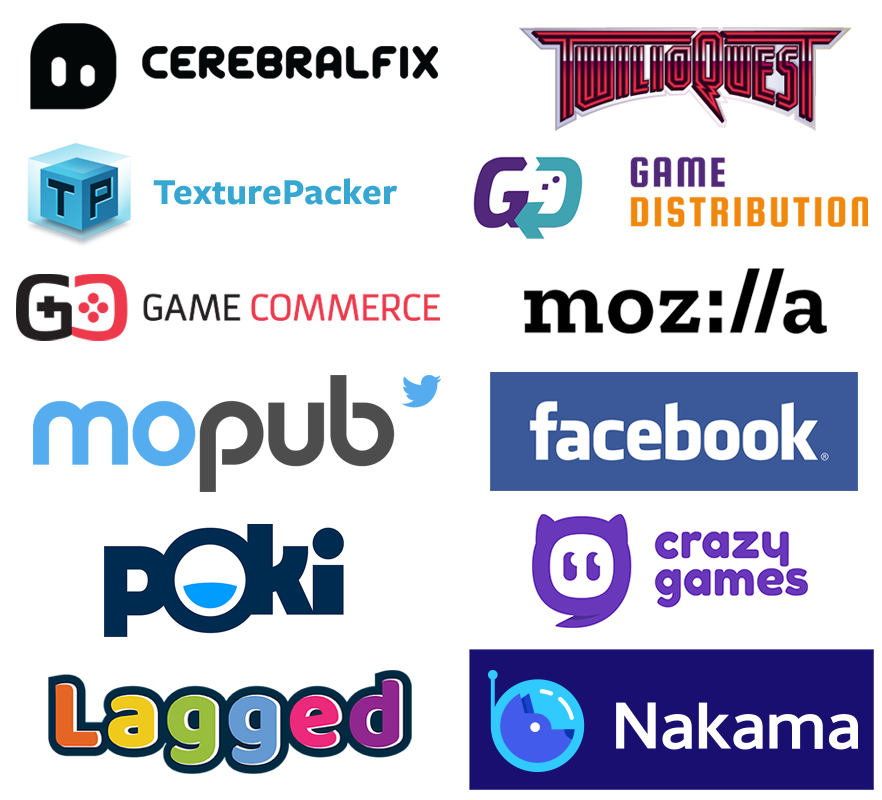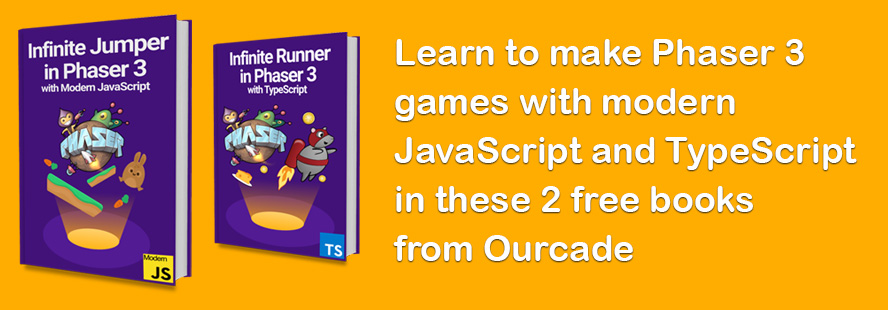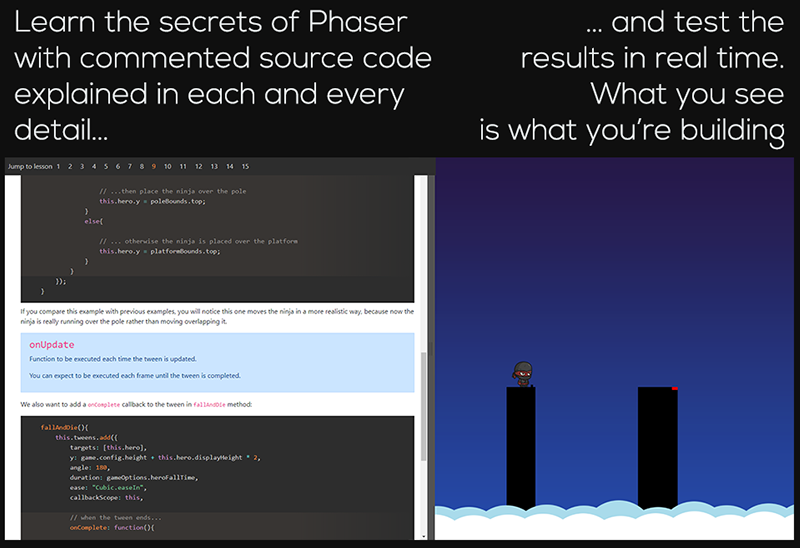Phaser is a fast, free, and fun open source HTML5 game framework that offers WebGL and Canvas rendering across desktop and mobile web browsers. Games can be compiled to iOS, Android and native apps by using 3rd party tools. You can use JavaScript or TypeScript for development.
Along with the fantastic open source community, Phaser is actively developed and maintained by Photon Storm. As a result of rapid support, and a developer friendly API, Phaser is currently one of the most starred game frameworks on GitHub.
Thousands of developers from indie and multi-national digital agencies, and universities worldwide use Phaser. Take a look at their incredible games in our showcase video:
Visit: The Phaser website and follow on Phaser Twitter
Play: Some of the amazing games #madewithphaser
Learn: API Docs, Support Forum and StackOverflow
Code: 2000+ Examples (source available in this repo)
Read: The Phaser World Newsletter
Discord: Join us on Discord
Extend: With Phaser Plugins
Be awesome: Support the future of Phaser
Grab the source and join the fun!
10th November 2023
The release of Phaser v3.60 in April 2023 was a huge deal for us. The culmination of 10 years of hard work. Even so, we didn't sit still 🙂 and after 5 heavily tested beta versions, we're back with v3.70!
Although feature-packed this release doesn't contain any major API breaking changes, so should be an easy upgrade from v3.60. The headliners are:
Texture Packer Nine Slice Support - We added the Nine Slice Game Object in version 3.60 but now Phaser can load Nine Slice data directly from a Texture Packer 7.1 atlas file. This makes it much easier to visually configure your Nine Slice sprites.
Arcade Physics Updates - Arcade Physics bodies can now be set to be under 'direct control'. When enabled, they'll automatically calculate their velocity based on positional changes. This allows you to directly move a Body around the physics world by just changing its position, without having to use acceleration or velocity. This is really useful if you want to move it via a Tween, or have it follow a Pointer, or a Path. Because its velocity is calculated based on this movement it will still resolve collisions with other bodies. We also added in support for Collision Groups into Arcade Physics, which allows for very fast filtering of groups of bodies and also the option to set the 'slide' factor of a moving body, great for Sokoban style games.
Round Pixels - We've now moved all of the 'round pixels' calculations off the CPU and onto the GPU. This means far less impact on performance when using this feature, which is great for pixel-art style games, or those that want to avoid sub-pixel rendering.
FX Updates - In v3.60 we introduced lots of really nice built-in FX, such as Bloom, Blur and Glow. In v3.70 you'll find several fixes related to these as well as the new ability to disable them via the game config. If you know you don't need to use them, disabling them saves boot-up time and memory, especially on mobile devices, as there are less shaders to compile and textures to prepare.
You'll also find over 100 fixes and updates as well as more new features not listed here. As usual, please check our detailed Change Log for v3.70.
v3.70 is available now from the Releases page and npm.
You'll find up to date TypeScript defs that align with this release in the types folder of this repository.
If you find any problems please report them in GitHub issues.
As usual, I'd like to send my thanks to the Phaser community for their help in both reporting issues and submitting pull requests to fix them 🙂
I'd like to send a massive thank-you to everyone who supports Phaser on Patreon, GitHub Sponsors and our corporate backers. Your continued funding allows me to keep working on Phaser full-time and this monster of a new release is the very real result of that. If you've ever considered becoming a backer, now is the perfect time!
If you'd like to stay abreast of developments then I'm now publishing them to the Phaser Patreon. Here you can find the latest development reports including the concepts behind Phaser 4.
You can also follow Phaser on Twitter and chat with fellow Phaser devs in our Discord.
Phaser 3 wouldn't have been possible without the fantastic support of the community and Patreon. Thank you to everyone who supports our work, who shares our belief in the future of HTML5 gaming, and Phaser's role in that.
Happy coding everyone!
Cheers,
Rich - @photonstorm
Because Phaser is an open source project, we cannot charge for it in the same way as traditional retail software. What's more, we don't ever want to. After all, it's built on, and was born from, open web standards. It's part of our manifesto that the core framework will always be free, even if you use it commercially, as many of you do.
You may not realize it, but because of this, we rely 100% on community backing to fund development.
Those funds allow Phaser to improve, and when it improves, everyone involved benefits. Your support helps secure a constant cycle of updates, fixes, new features and planning for the future.
We use Patreon to manage the backing and you can support Phaser from $1 per month. The amount you pledge is entirely up to you and can be changed as often as you like. Patreon renews monthly, just like Netflix. You can, of course, cancel at any point. Tears will be shed on this end, but that's not your concern.
Extra special thanks to the following companies whose support makes Phaser possible:
| 💖 | 💖 | 💖 |
|---|---|---|
| Hathora | Cerebral Fix | MoPub |
| Game Distribution | GameCommerce | |
| Mozilla | Texture Packer | TwilioQuest |
| Poki | CrazyGames | Lagged |
| Nakama | OP Games | You?! |
Phaser 3 is available via GitHub, npm and CDNs:
- Clone the git repository via https, ssh or with the GitHub Windows or Mac clients.
- Download as zip
- Download the build files: phaser.js and phaser.min.js
Install via npm:
npm install phaserPhaser is on jsDelivr which is a "super-fast CDN for developers". Include the following in your html:
<script src="//cdn.jsdelivr.net/npm/phaser@3.70.0/dist/phaser.js"></script>or the minified version:
<script src="//cdn.jsdelivr.net/npm/phaser@3.70.0/dist/phaser.min.js"></script>Go to https://newdocs.phaser.io/ to read the docs online using our brand new interface. Use the links to navigate the namespaces, classes and Game Objects lists and also use the new search box.
The documentation for Phaser 3 is an on-going project. Please help us by contributing improved docs and examples.
The TypeScript definitions can be found inside the types folder. They are also referenced in the types entry in package.json.
Depending on your project, you may need to add the following to your tsconfig.json file:
"lib": ["es6", "dom", "dom.iterable", "scripthost"],
"typeRoots": ["./node_modules/phaser/types"],
"types": ["Phaser"]We recently updated our Phaser 3 TypeScript Project Template, which you can use to get started with. This now uses TypeScript 5 and Phaser v3.60.
The TS defs are automatically generated from the JSDoc comments found in the Phaser source code. If you wish to help refine them then you must edit the Phaser JSDoc blocks directly, not the defs file. You can find more details about the parser we built in the scripts/tsgen folder.
We use Webpack to build Phaser and we take advantage of its conditional build flag feature to handle renderer swapping. If you wish to use Webpack with Phaser then please use our Phaser 3 Project Template as it's already set-up to handle the build conditions Phaser needs. Recent changes to our build steps mean you should now be able to use any other packager, like Parcel, without any config changes.
Phaser is released under the MIT License.
Tutorials and guides on Phaser 3 development are being published every week.
- Getting Started with Phaser 3 (useful if you are completely new to Phaser)
- Making your first Phaser 3 Game
- The Complete Phaser 3 Game Development course contains over 15 hours of videos covering all kinds of important topics.
- Plus, there are over 700 Phaser tutorials listed on the official website.
We've 3 tutorials related specifically to creating Facebook Instant Games with Phaser:
- Getting Started with Facebook Instant Games
- Facebook Instant Games Leaderboards Tutorial
- Displaying Ads in your Instant Games
During our development of Phaser 3, we created hundreds of examples with the full source code and assets ready available. These examples can be browsed on the Phaser 3 Labs, or clone the examples repo. We are constantly adding to and refining these examples.
Hathora Cloud is a scalable hosting platform for online multiplayer games. You upload your server project using the Hathora console or CLI, and then dynamically create server instances in 10+ regions around the world. You get charged only for the duration of active matches/sessions. It's perfect for nodejs servers handling WebSocket connections, and takes care of SSL termination (for wss) and DDoS protection.
They have also published a brand-new tutorial on creating a scalable multiplayer Phaser game. If you think this could be useful for your hosting needs, join their Discord server to get in touch.
Super community member RexRainbow has been publishing Phaser 3 content for years, building up an impressive catalogue in that time. You'll find loads of plugins, from UI controls such as text input boxes, to Firebase support, Finite State Machines and lots more. As well as the plugins there is also a comprehensive set of 'Notes' about Phaser 3, going into great detail about how the various systems work. It's an invaluable resource and well worth checking out at https://rexrainbow.github.io
Create an index.html page locally and paste the following code into it:
<!DOCTYPE html>
<html>
<head>
<script src="https://cdn.jsdelivr.net/npm/phaser@3.70.0/dist/phaser-arcade-physics.min.js"></script>
</head>
<body>
<script></script>
</body>
</html>This is a standard empty webpage. You'll notice there's a script tag that is pulling in a build of Phaser 3, but otherwise this webpage doesn't do anything yet. Now let's set-up the game config. Paste the following between the <script></script> tags:
const config = {
type: Phaser.AUTO,
width: 800,
height: 600,
physics: {
default: 'arcade',
arcade: {
gravity: { y: 200 }
}
},
scene: Example
};
const game = new Phaser.Game(config);config is a pretty standard Phaser 3 Game Configuration object. We tell config to use the WebGL renderer if it can, set the canvas to a size of 800 x 600 pixels, enable Arcade Physics, and finally we tell it to use the Example Scene. This hasn't been implemented yet, so if you run this JavaScript code now you will have an error. Add the following above the config:
class Example extends Phaser.Scene
{
constructor ()
{
super();
}
preload ()
{
this.load.setBaseURL('https://labs.phaser.io');
this.load.image('sky', 'assets/skies/space3.png');
this.load.image('logo', 'assets/sprites/phaser3-logo.png');
this.load.image('red', 'assets/particles/red.png');
}
create ()
{
}
}Here we create a Scene called Example. We've given it 2 functions. The preload function is where you load assets into your game. In preload, we set the Base URL to be the Phaser server and load 3 PNG files.
The create function is empty, so it's time to fill it in:
create ()
{
this.add.image(400, 300, 'sky');
const particles = this.add.particles(0, 0, 'red', {
speed: 100,
scale: { start: 1, end: 0 },
blendMode: 'ADD'
});
const logo = this.physics.add.image(400, 100, 'logo');
logo.setVelocity(100, 200);
logo.setBounce(1, 1);
logo.setCollideWorldBounds(true);
particles.startFollow(logo);
}Here we add a sky image into the game and create a Particle Emitter. The scale value means that the particles will initially be large and will shrink to nothing as their lifespan progresses.
After creating the emitter, we add a logo image called logo. Since logo is a Physics Image, logo is given a physics body by default. We set some properties for logo: velocity, bounce (or restitution), and collision with the world bounds. These properties will make our logo bounce around the screen. Finally, we tell the particle emitter to follow the logo - so as the logo moves, the particles will flow from it.
Run it in your browser and you'll see the following:
(Got an error? Here's the full code)
This is a tiny example, and there are hundreds more for you to explore, but hopefully it shows how expressive and quick Phaser is to use. With just a few easily readable lines of code, we've got something pretty impressive up on screen!
Ourcade have published two great Phaser 3 books. They'll take you from getting set-up, through to finishing your first game using modern JavaScript or TypeScript and they're both completely free! They also publish a huge range of quality tutorials and videos, so be sure to check out their site every week.
Learn the secrets of HTML5 game development with Phaser 3.50 while building a cross platform endless runner game. Designed both for beginners and skilled programmers, the course guides you from an empty folder introducing the bare bones of JavaScript to advanced Phaser 3 features. Find out more details about HTML5 Cross Platform Game Development with Phaser.
There are both plain and minified compiled versions of Phaser in the dist folder of the repository. The plain version is for use during development, and the minified version is for production use. You can and should also create your own builds.
Phaser 3 is built using Webpack and we take advantage of the Webpack definePlugin feature to allow for conditional building of the Canvas and WebGL renderers and extra plugins. You can custom the build process to only include the features you require. Doing so can cut the main build file size down to just 70KB.
Read our comprehensive guide on creating Custom Builds of Phaser 3 for full details.
If you wish to build Phaser 3 from source, ensure you have the required packages by cloning the repository and then running npm install on your source directory.
You can then run webpack to create a development build in the build folder which includes source maps for local testing. You can also npm run dist to create a minified packaged build in the dist folder. For a list of all commands available use npm run help.
Due to the increasing size of our Change Logs we have now split them up, one version per folder.
We've organized the Change Logs into commonly themed sections to make it more digestible, but we appreciate there is a lot in there. Please don't feel overwhelmed! If you need clarification about something, join us on the Phaser Discord and ask.
The Contributors Guide contains full details on how to help with Phaser development. The main points are:
-
Found a bug? Report it on GitHub Issues and include a code sample. Please state which version of Phaser you are using! This is vitally important.
-
Before submitting a Pull Request run your code through ES Lint using our config and respect our Editor Config.
-
Before contributing read the code of conduct.
Written something cool in Phaser? Please tell us about it in the forum, or email support@phaser.io
Phaser is a Photon Storm production.
Created by Richard Davey. Powered by coffee, anime, pixels and love.
The Phaser logo and characters are © 2011 - 2023 Photon Storm Limited.
All rights reserved.
"Above all, video games are meant to be just one thing: fun. Fun for everyone." - Satoru Iwata





















